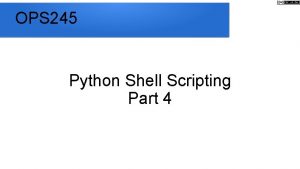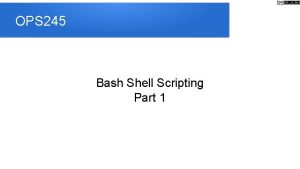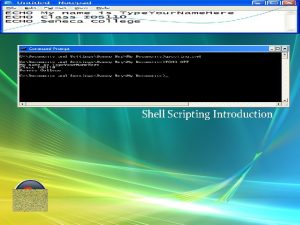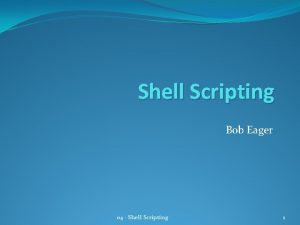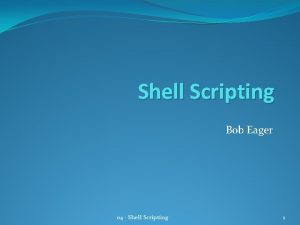OPS 245 Python Shell Scripting Part 3 Outline












- Slides: 12

OPS 245 Python Shell Scripting Part 3

Outline In this lesson you will learn to handle errors that occur while your script is running. Instead of simply crashing, or doing something unpredictable, your scripts will be able to deal with issues gracefully.

Try When running a block of code that could cause a problem if something went wrong (e. g. trying to read from a file provided by the user, but our script doesn’t know for certain that the file exists), use a try block: try: #some potentially troublesome code #indented, of course

Except But try on its own won’t do anything. We need to indicate how we want to handle errors that might occur. For this we need the except statement: try: #some potentially troublesome code except: #code to run if anything went wrong

Sometimes you will only want to handle certain exceptions. You do this by adding the exception name after except: Specific Exceptions try: #some potentially troublesome code except <exceptionname>: #code to run if that particular thing went wrong.

If you want your except block to deal with several possible exceptions, you can provide a comma separated list of them surrounded by parenthesis: Multiple Specific Exceptions except (<exceptionname>, <otherexception>, <anotherexception): #code to run if one of those things went wrong Though, in this case it would deal with all three (or however many) exceptions the same way.

try: #some potentially troublesome code Different Exceptions except <exceptionname>: #code to run if that particular thing went wrong except <differentexception>: #code to run for this particular exception

There a number of different exceptions you can encounter (see reference at end of slides) including: Exception Names We will add some more to the list we know about when we start working with files. Index. Error – when giving an index outside the bounds of a list. Name. Error – when trying to use a variable that you didn’t create yet. Type. Error – when trying to use the wrong type of variable. Zero. Division. Error – when trying to divide by 0.

Else You can also use an else in a try statement, to set up code to run only if nothing went wrong: try: #some potentially troublesome code except: #code to run if anything went wrong else: #Code to run only if nothing went wrong You don’t need to have an else, but it can be useful.

Finally You can also define code to run regardless of whether any errors happened or not: try: #some potentially troublesome code except: #code to run if anything went wrong finally: #code to run regardless of errors

Summary In this lesson you have learned to use python’s try-except statement to handle errors that might occur while your scripts are running. This allows you to make your scripts more robust, and to deal with the unpredictable nature of users. We can at least make sure our scripts don’t leave the system in a broken state.

You may find the following References documents helpful: Python Errors and Exceptions List of Built-in Exceptions













